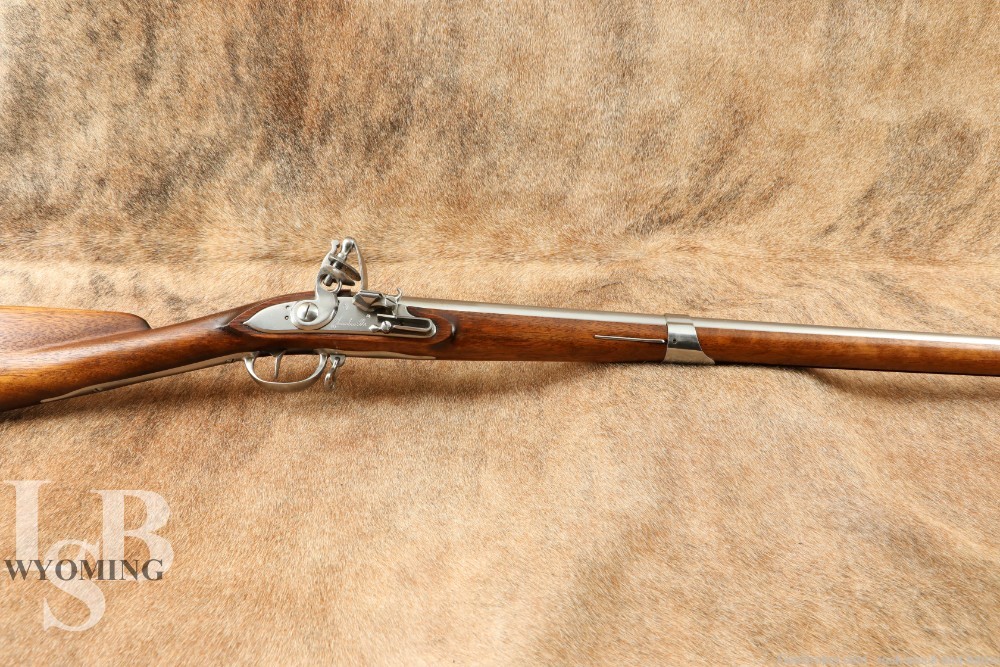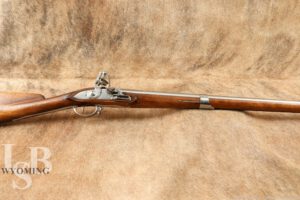
Charleville Model 1776 Musket .69 Cal Navy Arms Flintlock ATF Antique
SOLD FOR: $1,350.00
LSB#: WY240909LW002
Make: Navy Arms Ridgefield N.Y.
Model: Model 1776 Musket
Serial#: NSN
Year of Manufacture: Modern
Caliber: .69 Cal
Action Type: Muzzleloader, Flintlock (No Flint with this musket)
Markings: The lock plate is marked “CHARLEVILLE”, with a Fleur De Lis. The left side of the barrel is marked “Navy Arms Ridgefield N.Y. 2481”, The tang is marked “Japan”.
Barrel Length: 44.5”
Sights/ Optics: The front sight is a shallow blade. There is no rear sight.
Stock Configuration & Condition/ Grip: The wood stock has a straight grip, metal nose cap with cut out for the included ramrod, barrel band with sling loop, barrel band, trigger guard assembly mounted sling loop, and metal buttplate. The buttplate is in fine shape. There are light compression marks throughout the wood. There are no cracks to be seen. There is light wear along the edges of the ramrod channel. The LOP measures 12.5” from the front of the trigger to the rear of the buttplate. The stock rates in about Excellent overall condition.
Type of Finish: In the White
Finish Originality: Original
Bore Condition: The smoothbore is bright. There is no visible pitting present. This bore rates 10/10 in this writer’s opinion.
Overall Condition: This musket retains 98% of its metal finish. The finish on the metal parts is gleaming with that Charleville newness. There are some hard surface scars on the lock plate on the left side of the musket. There are no scuffs, or scratches to be noted. There is no tarnish to the metal. The screw heads are sharp. The markings are clear. Overall, this musket rates in about excellent condition.
Mechanics: The action functions correctly. We did not fire this musket. As with all used firearms, a thorough cleaning may be necessary to meet your maintenance requirements.
Box Paperwork and Accessories: The musket comes with no flint but a ramrod is installed.
Our Assessment: (Reference Wiki) Marin le Bourgeoys created the first true flintlock weapons for King Louis XIII shortly after his accession to the throne in 1610.[2] Throughout the 17th century, flintlock muskets were produced in a wide variety of models.
In 1717, a flintlock musket for the French infantry was standardized. This became the first standard flintlock musket to be issued to all French troops. While it is more correctly called a French infantry musket or a French pattern musket, these muskets later became known as “Charleville muskets”, after the armory in Charleville-Mézières, Ardennes, France.[3] The standard French infantry-long gun was also produced at Tulle, Saint-Étienne, Maubeuge Arsenal, and other sites. While technically not the correct name for these muskets, the use of the name Charleville dates back to the U.S. Revolutionary War, when Americans tended to refer to all of the musket models as Charlevilles. The naming of these muskets is not consistent.
Some references only refer to Model 1763 and later versions as Charleville flintlock muskets, while other references refer to all models as the Charleville. The Charleville musket’s design was refined several times during its service life. Later models of Charleville muskets remained in service until 1840, when percussion lock systems made the flintlock mechanism obsolete.[4]The Model 1763’s sturdier design proved to be a bit too heavy, so in 1766 the musket’s design was lightened.
The barrel wall was thinned, the lock was shortened, the stock was slimmed, and the Model 1763’s long iron ramrod cover was replaced by a pinned spring under the breech. The trumpet shaped ramrod of the Model 1763 was also abandoned in favor of a ramrod with a lighter button shaped end. Though usually considered to be a separate model, the Model 1766 was often referred to as a “light Model 1763” musket, especially in Revolutionary War invoices.[5] Despite being thinned down, the Model 1766 proved to be rugged and reliable. A total of 140,000 Model 1766 muskets were produced.
The finish on the metal has been almost entirely clear of tarnish and gleams like the day these muskets came off the line. The smoothbore has no rust or fouling. Given the condition of the stock, shooting this musket would be encouraged. This is a good example of the first mass produced long arm, a 250 year old tradition that lives on today. So bid high and bid firm. I highly encourage you to take a look at the condition in our high quality photos. Good luck on your bid. -K.F.

